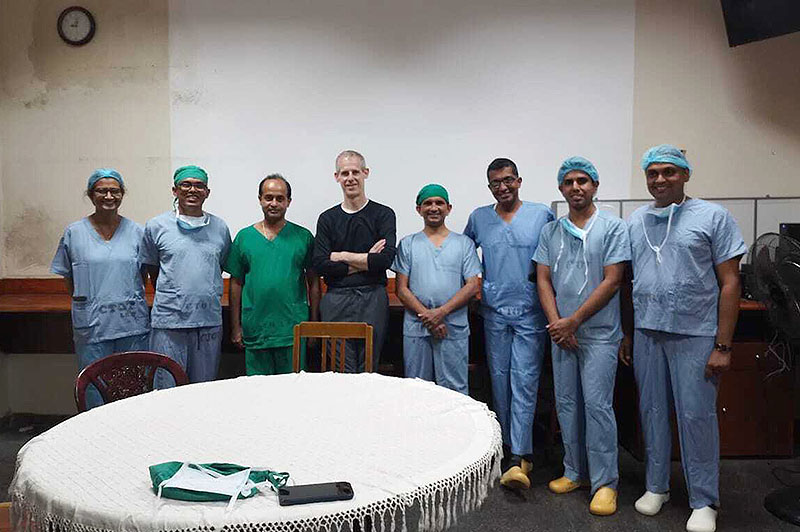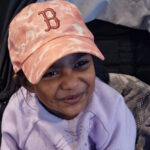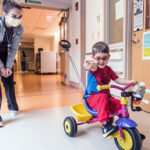A surgeon’s last-minute trip to Sri Lanka reduces children’s wait for needed heart repair

Last year, Dr. Christopher Baird got an offer he couldn’t refuse — something that happens often as he travels the world to demonstrate the heart surgery techniques he has learned and developed at Boston Children’s Hospital.
At a heart surgery symposium in India, Dr. Baird had just performed a complex type of aortic valve reconstruction on a child when a cardiac surgeon asked him to visit Sri Lanka. He wanted Dr. Baird to teach his surgical team how to operate on children who have Ebstein’s anomaly, a rare congenital heart defect (CHD) that affects the valve between the heart’s two right-side chambers, the tricuspid valve.
Dr. Baird understood the urgency of the invitation. There are only a small handful of pediatric cardiac surgeons in a country that has 2.9 million children. Heart care at the surgeons’ hospital, Lady Ridgeway Hospital for Children, is among the most advanced in South Asia, but that hasn’t helped them reduce the long waiting list for complex procedures.
Rather than going home to Boston after the conference, Dr. Baird flew to Sri Lanka.
Continuing a cycle of learning and sharing
Dr. Baird’s trips to Sri Lanka and India are an example of how surgeons often pay it forward. His travels are part of the many global health efforts that bring Boston Children’s expertise to children and their physicians across the world. And Dr. Baird himself benefitted from this tradition when he learned aortic valve reconstruction from Dr. Shigeyuki Ozaki, the surgeon who developed the procedure and for whom it is named. Dr. Ozaki came to Boston Children’s in 2015 to oversee two operations Dr. Baird conducted as he became the first surgeon to apply the Ozaki procedure on children.
Dr. Baird returned the favor by teaching the Ozaki procedure to pediatric surgeons in Chile, China, Vietnam, the Republic of Georgia, India, and Morocco. He has also had audiences in Egypt, Japan, Malaysia, and other countries for surgeries that repair CHD in the heart’s many valves — aortic, mitral, tricuspid, and pulmonary — as well as those that treat aortic arch and single ventricle defects.
“It’s rewarding to share this knowledge,” says Dr. Baird, who is director of the Congenital Heart Valve Program. “My colleagues and I are in a fortunate position where we can help many more patients beyond Boston Children’s.”
Overbooked with surgeries, Sri Lanka doctors prefer drop-by instruction
Lady Ridgeway Hospital for Children has just three cardiac surgeons, and each year they perform about 800 operations on children of all ages. They know many complex procedures but also recognize pediatric hospitals such as Boston Children’s are often improving traditional surgical techniques and creating new ones. They occasionally attend conferences to learn more about surgical innovations but with a backlog of patients waiting for treatment, they don’t leave Lady Ridgeway as often as they’d like.
“We have children who are waiting for surgeries that require some of the newer techniques that we wanted to learn from Dr. Baird,” says Dr. Kanchana Singappuli, one of the pediatric cardiac surgeons. “Him coming to Sri Lanka and teaching us was a great opportunity.”
On that long list are children with Ebstein’s anomaly. The rare condition affects the leaflets, or flaps, of the heart’s tricuspid valve. Leaflets control blood flow, but when they aren’t fully formed or are set in the wrong position, blood backs up, enlarging the right atrium and potentially leading to congestive heart failure.
There are several ways to treat Ebstein’s anomaly. Heart surgeons can move a malformed tricuspid valve and reconfigure its leaflets. If the valve is beyond repair, they can replace it with a mechanical or prosthetic one. The Lady Ridgeway cardiac surgery team wanted to learn another type of treatment, the Cone procedure. It’s a more involved surgery than the other two, but studies have shown it delivers better results for children, including lessening the need for a replacement valve later in life.
Teaching surgery under a spotlight
For four days in May, Dr. Baird worked side-by-side with the Lady Ridgeway cardiac surgeons, performing three operations a day. Dr. Baird showed them how to fold up extra tissue on the enlarged right side of the heart and then how to reshape the malformed tricuspid valve into a cone that opens and closes. He wore a microphone as smartphones recorded the procedures. “I showed them how to do it and sometimes they had questions,” Dr. Baird recalls. “They got comfortable with it, and now they can do it on their own and help many more patients.”
They also worked together on a few aortic valve repairs. Dr. Muditha Lansakara, who approached Dr. Baird at the symposium in India and extended the invitation to visit Lady Ridgeway, says all the patients they operated on have recovered.
“It has been very good learning for us,” adds Dr. Singappuli. “We tend to lag behind some of the progress in our field. By having an affiliation with a hospital like Boston Children’s, which is at the forefront of everything, we can lift ourselves up.”
Developing long-lasting partnerships
Surgeons stay in touch with Dr. Baird once he leaves. They have more questions and often want the scoop about new procedures he and the Cardiac Surgery team are developing. Not long after Dr. Baird returned from Sri Lanka, Dr. Singappuli texted, “Can you help me figure out this case?” They then exchanged texts about how to approach a surgery for a child who had only two aortic valve leaflets.
Follow-up texts from other heart surgeons could be coming soon. Aside from the surgeons he has met overseas, Dr. Baird also exchanges ideas and offers advice to surgeons in the U.S. This year, he will travel the world to demonstrate the techniques of heart valve surgery, biventricular repair, and aortic arch reconstruction and airway surgery.
A teaching opportunity in Malaysia eight years ago reminded Dr. Baird that every technique he shares with other surgeons, no matter how small, has value. “They were performing a cardiopulmonary bypass,” he recalls. “I suggested, ‘Make an incision like this.’ They did, and I didn’t think much about it. Months later, the surgeon there said what I showed them helped them do a similar operation on eight more children over the following months.”
Learn more about the Department of Surgery’s global impact, or request an appointment.
Related Posts :
-

After surgery for heart condition tetralogy of Fallot, James is all joy
Warriors come in all shapes and sizes. Some even smile. In the Irvine family, the lead warrior is a happy ...
-

From South Africa to Boston: Kyleigh's four-year search for good heart health
Kyleigh Kista had three open-heart surgeries in just the first 18 months of her life. But instead of progressing, her ...
-

From Pakistan to Boston: Faiz finally found help for his complex heart condition
Don’t let his shy smile fool you. In his hometown of Lahore, Pakistan, 6-year-old Muhammad Butt is known by ...
-

A 'super' new heart surgery for a super kid
When you’re the first person in the world to undergo a new type of heart surgery, you don’t ...





